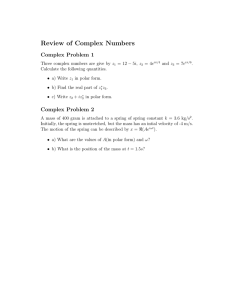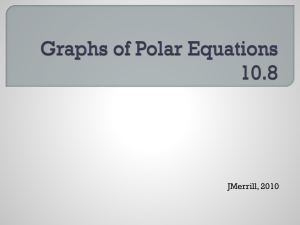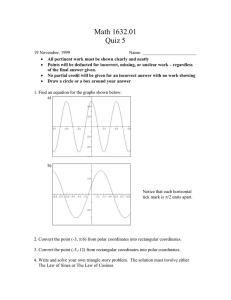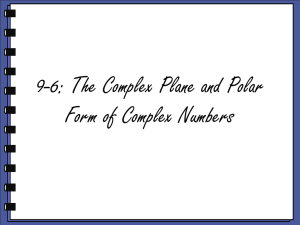Working With the Complex Numbers System
advertisement
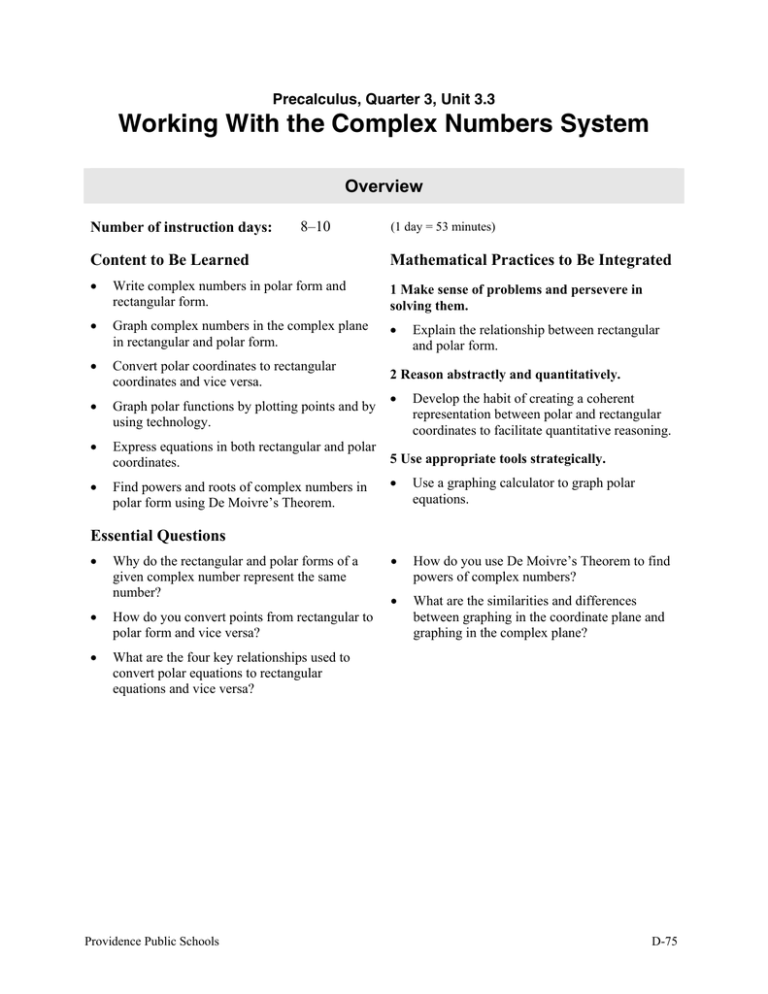
Precalculus, Quarter 3, Unit 3.3 Working With the Complex Numbers System Overview Number of instruction days: 8–10 Content to Be Learned (1 day = 53 minutes) Mathematical Practices to Be Integrated Write complex numbers in polar form and rectangular form. 1 Make sense of problems and persevere in solving them. Graph complex numbers in the complex plane in rectangular and polar form. Convert polar coordinates to rectangular coordinates and vice versa. 2 Reason abstractly and quantitatively. Graph polar functions by plotting points and by using technology. Express equations in both rectangular and polar coordinates. Find powers and roots of complex numbers in polar form using De Moivre’s Theorem. Explain the relationship between rectangular and polar form. Develop the habit of creating a coherent representation between polar and rectangular coordinates to facilitate quantitative reasoning. 5 Use appropriate tools strategically. Use a graphing calculator to graph polar equations. How do you use De Moivre’s Theorem to find powers of complex numbers? What are the similarities and differences between graphing in the coordinate plane and graphing in the complex plane? Essential Questions Why do the rectangular and polar forms of a given complex number represent the same number? How do you convert points from rectangular to polar form and vice versa? What are the four key relationships used to convert polar equations to rectangular equations and vice versa? Providence Public Schools D-75 Precalculus, Quarter 3, Unit 3.3 Version 4 Working With the Complex Numbers System (8–10 days) Standards Common Core State Standards for Mathematical Content Number and Quantity The Complex Number System N-CN Represent complex numbers and their operations on the complex plane. N-CN.4 (+) Represent complex numbers on the complex plane in rectangular and polar form (including real and imaginary numbers), and explain why the rectangular and polar forms of a given complex number represent the same number. ACT’s College Readiness Standards: Mathematics 1.1.a Define polar coordinates to locate a point on a graph. 1.1.b Graph polar functions by plotting points and by using technology. 1.1.c Express two-dimensional points and equations in rectangular and polar coordinates. 1.1.d Find powers and roots of complex numbers in polar form using De Moivre’s theorem. Common Core State Standards for Mathematical Practice 1 Make sense of problems and persevere in solving them. Mathematically proficient students start by explaining to themselves the meaning of a problem and looking for entry points to its solution. They analyze givens, constraints, relationships, and goals. They make conjectures about the form and meaning of the solution and plan a solution pathway rather than simply jumping into a solution attempt. They consider analogous problems, and try special cases and simpler forms of the original problem in order to gain insight into its solution. They monitor and evaluate their progress and change course if necessary. Older students might, depending on the context of the problem, transform algebraic expressions or change the viewing window on their graphing calculator to get the information they need. Mathematically proficient students can explain correspondences between equations, verbal descriptions, tables, and graphs or draw diagrams of important features and relationships, graph data, and search for regularity or trends. Younger students might rely on using concrete objects or pictures to help conceptualize and solve a problem. Mathematically proficient students check their answers to problems using a different method, and they continually ask themselves, “Does this make sense?” They can understand the approaches of others to solving complex problems and identify correspondences between different approaches. 2 Reason abstractly and quantitatively. Mathematically proficient students make sense of the quantities and their relationships in problem situations. Students bring two complementary abilities to bear on problems involving quantitative relationships: the ability to decontextualize—to abstract a given situation and represent it symbolically and manipulate the representing symbols as if they have a life of their own, without necessarily attending to their referents—and the ability to contextualize, to pause as needed during the manipulation process in order to probe into the referents for the symbols involved. Quantitative reasoning entails habits of creating D-76 Providence Public Schools Working With the Complex Numbers System (8–10 days) Precalculus, Quarter 3, Unit 3.3 Version 4 a coherent representation of the problem at hand; considering the units involved; attending to the meaning of quantities, not just how to compute them; and knowing and flexibly using different properties of operations and objects. 5 Use appropriate tools strategically. Mathematically proficient students consider the available tools when solving a mathematical problem. These tools might include pencil and paper, concrete models, a ruler, a protractor, a calculator, a spreadsheet, a computer algebra system, a statistical package, or dynamic geometry software. Proficient students are sufficiently familiar with tools appropriate for their grade or course to make sound decisions about when each of these tools might be helpful, recognizing both the insight to be gained and their limitations. For example, mathematically proficient high school students analyze graphs of functions and solutions generated using a graphing calculator. They detect possible errors by strategically using estimation and other mathematical knowledge. When making mathematical models, they know that technology can enable them to visualize the results of varying assumptions, explore consequences, and compare predictions with data. Mathematically proficient students at various grade levels are able to identify relevant external mathematical resources, such as digital content located on a website, and use them to pose or solve problems. They are able to use technological tools to explore and deepen their understanding of concepts. Clarifying the Standards Prior Learning As early as kindergarten, students studied patterning to start their conceptual understanding of algebraic reasoning. Adding, subtracting, multiplying, and dividing rational numbers is the culmination of numerical work with the four basic operations. Students continued to develop understanding of the number system in Grade 8; with the introduction of irrational numbers, they expanded their understanding to real numbers. With the introduction of imaginary numbers in high school, students’ understanding of the number system expanded to include complex numbers. Because there are no specific standards for rational number arithmetic in later grades, and because so much other work in Grade 7 depended on rational numbers, fluency with rational number arithmetic should have been mastered in Grade 7. Algebra II students have already worked with complex numbers. They performed arithmetic operations (only addition, subtraction, and multiplication) with complex numbers and used complex numbers in polynomials (with real coefficients), identities, and equations. They solved quadratic equations with real coefficients that have complex solutions and extended the polynomial identities to the complex numbers. They have also shown that the Fundamental Theorem of Algebra is true for quadratic polynomials. Current Learning Precalculus students write and graph complex numbers in polar form and rectangular form. They develop relationships such as x 2 y 2 r 2 , tan y x , x r cos , and y r sin in order to facilitate changing polar equations to rectangular equations and vice versa. They plot simple polar graphs by plotting points. Students use a graphing calculator to investigate more difficult graphs of polar equations, and they use De Moivre’s Theorem to find powers and roots of complex numbers in polar form. Providence Public Schools D-77 Precalculus, Quarter 3, Unit 3.3 Version 4 Working With the Complex Numbers System (8–10 days) Future Learning In AP Calculus BC, students will study polar equations. They will graph polar equations by hand, and they will find the equations of lines tangent to polar curves. They will also find areas of regions created by polar equations, such as the area of one petal of a rose. Polar equations are used for satellite tracking and other astronomical applications. Additional Findings It is important that students gain experience using multiple representations to deepen their understanding. “Students should recognize connections among different representations, thus enabling them to use these representations flexibly.” (Principles and Standards for School Mathematics, p. 309) Assessment When constructing an end-of-unit assessment, be aware that the assessment should measure your students’ understanding of the big ideas indicated within the standards. The CCSS for Mathematical Content and the CCSS for Mathematical Practice should be considered when designing assessments. Standards-based mathematics assessment items should vary in difficulty, content, and type. The assessment should comprise a mix of items, which could include multiple choice items, short and extended response items, and performance-based tasks. When creating your assessment, you should be mindful when an item could be differentiated to address the needs of students in your class. The mathematical concepts below are not a prioritized list of assessment items, and your assessment is not limited to these concepts. However, care should be given to assess the skills the students have developed within this unit. The assessment should provide you with credible evidence as to your students’ attainment of the mathematics within the unit. Represent complex numbers on the complex plane in rectangular and polar form. Know and explain why both rectangular and polar forms represent the same complex number. Transform complex numbers in a complex plane from rectangular to polar form and vice versa. Use De Moivre’s Theorem to find powers of complex numbers. Write and graph the polar form of a linear equation. Convert equations from polar form to rectangular form and vice versa. D-78 Providence Public Schools Working With the Complex Numbers System (8–10 days) Precalculus, Quarter 3, Unit 3.3 Version 4 Instruction Learning Objectives Students will be able to: Use polar coordinates to represent points on a plane. Convert points between rectangular and polar coordinates. Convert equations from polar to rectangular form, and vice versa. Graph complex numbers in the complex plane. Find powers and roots of complex numbers in polar form using De Moivre’s Theorem. Review and demonstrate knowledge of important concepts and procedures related to the complex number system. Resources Advanced Mathematical Concepts: Precalculus with Applications, Glencoe, 2006, Teacher Edition and Student Edition Section 9-1 (pp. 553-560) Section 9-3 (pp. 568-573) Section 9-4 (pp. 574 – 579) Section 9-6 (pp. 586 - 591) Section 9-8 (pp. 599 – 606) TeacherWorks All-In-One Planner and Resource Center CD-ROM Exam View Assessment Suite TI-Nspire Teacher Software Polar Coordinates activity can be found at education.ti.com. See the Supplementary Materials section of this binder for the student and teacher notes for this activity. Note: The district resources may contain content that goes beyond the standards addressed in this unit. See the Planning for Effective Instructional Design and Delivery and Assessment sections for specific recommendations. Materials TI-Nspire graphing calculators Providence Public Schools D-79 Precalculus, Quarter 3, Unit 3.3 Version 4 Working With the Complex Numbers System (8–10 days) Instructional Considerations Key Vocabulary rectangular form of a complex number polar coordinates Planning for Effective Instructional Design and Delivery Reinforced vocabulary taught in previous grades or units: amplitude, complex numbers, complex plane (Argand plane), definition of i, and imaginary number. Students in Precalculus will be continuing the study of complex numbers. This will be the development stage of complex numbers on the polar plane. Students have not converted points from the rectangular to polar coordinate system; therefore, they will need to study those conversions before using complex numbers in the two planes. Students will need to use their knowledge of the trigonometric functions in converting complex numbers from rectangular to polar coordinates. Students will need a reminder of the powers of i. Have students make a graphic organizer to review their knowledge. Students can use an identifying similarities and differences strategy to represent the cyclical nature of imaginary numbers. They can make a comparison matrix to show how multiplying 1 by itself x amount of times gives a pattern: i0 1 i 1 i i 2 –1 i3 –i i 4 1 i 5 i Have students show what kind of parabolic graphs are associated with complex numbers. Also, have students make a quadratic function with complex roots, solve using conjugates, and share out their findings with the whole class. Draw a coordinate plane on the board. The x-axis will represent all real numbers and the y-axis will represent imaginary numbers. Student will get a card with different real/imaginary numbers written on it. The students will use sticky notes to locate the position of the numbers on the graph. (The lines and sticky notes will remain here until the closing when the students will be asked to come back up to the board and reevaluate their positions.) Students should be able to answer the essential questions after completing this assignment. Have students in groups of three apply their knowledge by identifying similarities and differences between rectangular and complex coordinates, making a graph of each kind on poster board, and then comparing the coordinates. Each group should share out their findings and connect their graph to a realworld situation. Extend this activity by including the polar plane. Students may make a graphic organizer to show how the points will look on each of these graphs. Students must have a conceptual understanding of how to use the calculator to graph polar functions. Students should work in cooperative groups and use technology to graph polar functions. Be sure to pay attention to the calculator Teaching Tips provided in each section. Additionally, the Graphing Calculator D-80 Providence Public Schools Working With the Complex Numbers System (8–10 days) Precalculus, Quarter 3, Unit 3.3 Version 4 Exploration on p. 602 in the textbook provides an opportunity for students to quickly explore roots of a complex number using technology. The Polar Coordinates activity on education.ti.com is an additional option aligned with this unit. In this activity, students have brief introduction to the polar coordinate system. They develop a basic understanding of the polar coordinate system and locate points given in polar form. Students also convert between polar and rectangular coordinates and sketch graphs of polar functions. TI-Nspire resources can be found using the TI-Nspire Teacher Software on your school computer. The content tab of the TI-Nspire desktop software contains links to Advanced Mathematical Concepts, Glencoe McGraw-Hill, 2006 textbook. These resources are accessible by chapter and section. Notes Providence Public Schools D-81 Precalculus, Quarter 3, Unit 3.3 Version 4 D-82 Working With the Complex Numbers System (8–10 days) Providence Public Schools
